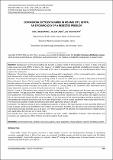| dc.contributor.author | Cholo Wilberforce, Wilson Odero, Diana Menya | |
| dc.date.accessioned | 2020-08-10T08:09:43Z | |
| dc.date.available | 2020-08-10T08:09:43Z | |
| dc.date.issued | 2015-04 | |
| dc.identifier.citation | 1 | en_US |
| dc.identifier.issn | 2351-8014 | |
| dc.identifier.uri | https://repository.maseno.ac.ke/handle/123456789/1916 | |
| dc.description | The article can also be accessed in full text via URL,
http://www.ijisr.issr-journals.org | en_US |
| dc.description.abstract | : Background: Commercial bicycling has become a popular mode of transportation in Kenya, in both rural and
urban areas since early 1990’s. In Kisumu city, however, its related injuries cause significant morbidity and mortality. Many
road users have viewed their presence in the roads as the cause of congestion, confusion, fear, and decreased safety in the
roads in the road system.
Objectives: The primary objectives were; to determine demographic characteristics of the commercial bicyclists, magnitude
and characteristics of road traffic crashes and injuries involving commercial bicycling. Methods: Cross-sectional descriptive study involving review of medical and traffic police records in New Nyanza Provincial
General Hospital, Kisumu District hospital, and Traffic police station records departments respectively, was used to status of
bicyclist crashes and injuries in Kisumu City. Hospital and police records were reviewed to determine road traffic crashes and
injuries involving commercial bicyclist for a period of one year, 1st January 2008 to 31st December 2008. Information about
injury disposition, severity, outcome of injuries were entered in designed forms.
Results: A total of 209 patients were treated for bicycle- related injuries in both hospitals and 64 cases were recorded in
police records. The age group most affected in road trauma involving bicyclists was 21-30 years accounting for 32.1%. 45.9%
were pedestrians hit by bicyclists, 46.9% of the bicycle related casualties reported by the traffic police were slightly injured,
28.1 % were seriously injured and 25% were fatal cases. Of the fatal cases 56.3% were passengers carried by bicyclists, 25%
were pedestrians knocked by bicyclists and 18.7% were bicycle riders. 9.3% of injuries occurred in major roads within the city.
The majority of casualties in police derived data were adults aged above 16 years (78.2%).
Conclusion: The high prevalence of bicycle related cases calls for a review of the local situation so that concerted efforts are
made to design coordinated and effective interventions for commercial bicyclists. The age group most commonly affected in
road trauma involving bicyclists was 21-30 years. Over three quarters of the patients who sustained bicycle related injuries
were aged below 40 years and were mainly males.
Cut wounds were most commonly sustained followed by head injuries, dislocations, fractures while lacerations and
contusions are sustained less. Most of those who died sustained head injuries. | en_US |
| dc.publisher | International Journal of Innovation and Scientific Research | en_US |
| dc.subject | : Commercial bicycle, fatalities, Injuries, Casualties, Injury disposition, injury outcome, severity, morbidity, burden | en_US |
| dc.title | Commercial Bicyclist Injuries in Kisumu City, Kenya: an Epidemiology of a Neglected Problem | en_US |
| dc.type | Article | en_US |

